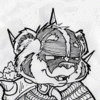
These are some assorted mechanical bits that go on a Fw190. Some this are things that will not really be visible in the picture, but gaining a better understanding of what defines one type of mechanical device from another helps at least me the artist create a more believable picture. Also one learns little details before one starts on a final piece.
Example. The propeller blades of the Fw190 were painted a black/green color while the the 12 blade cooling fan located directly behind the propeller is painted just black. Why is that so? Why didn't the Germans paint both one color? Is it because the cooling fan blades operated at a higher temperatures and therefore required a different paint? Were cooling fan blades made of a different material than the propellers blades themselves and did the black paint not adhere as well? Did the black/green paint cost less and therefore it was a matter of economics?
Example. The propeller blades of the Fw190 were painted a black/green color while the the 12 blade cooling fan located directly behind the propeller is painted just black. Why is that so? Why didn't the Germans paint both one color? Is it because the cooling fan blades operated at a higher temperatures and therefore required a different paint? Were cooling fan blades made of a different material than the propellers blades themselves and did the black paint not adhere as well? Did the black/green paint cost less and therefore it was a matter of economics?
Category All / All
Species Unspecified / Any
Size 1132 x 969px
File Size 106.8 kB
But back to the original question. No, all propellers were supposed to be painted RLM 70 Schwarzgrün ( Blackgreen ) while the Fan blades were painted RLM 66 Schwarzgrau ( Blackgray ) or RLM 22 Schwarz ( black ), sometime they did not have any paint on them tho..same with the lower wings.
It is very hard to be sure from a resored plane as they quite often were repainted completely incorrect ( only recentely did they start to do good jobs as they found more and more complete planes and wrecks in Russia and from the bottom of lakes so they had original painted samples )
It is very hard to be sure from a resored plane as they quite often were repainted completely incorrect ( only recentely did they start to do good jobs as they found more and more complete planes and wrecks in Russia and from the bottom of lakes so they had original painted samples )
Cool! In all honesty the cooling fans will be barely visible in you picture but I've learned an important lesson over the years about drawing. As a general rule the more you know about the subject you are drawing the better you can render it. Even it is irrelevant to the immediate piece it helps you understand and gain confidence. That will usually show in your work.
The cooling fan rotates 5:1 of the main propeller and was necessary since the 190 engine was a air cooled starlike engine.
At/before the beginnig of the war water cooled engines were the main, since nobody thought air cooled ones could bring the needed power - germans showed it is possilbe.
Still - they never solved the problem of the overheating bottom cylinder...
And since the fan is part of the engine i think they came out there in one standard colour.
At/before the beginnig of the war water cooled engines were the main, since nobody thought air cooled ones could bring the needed power - germans showed it is possilbe.
Still - they never solved the problem of the overheating bottom cylinder...
And since the fan is part of the engine i think they came out there in one standard colour.
If I remember correctly, the BMW engines were delivered as a 'power egg', already fully assembled and ready to mount; the propellors were produced by a different manufacturer. RLM regulations prescribed that the interior of engine compartments were painted in RLM 02, with the exception of the firewall. This was painted RLM 02 on the cockpit side, but left unpainted on the engine side in most cases. All engine support braces, connecting rods and internal framework was also RLM 02 (RLM Grau). Pipelines for fuel, oil and coolant remained unpainted outside of the cockpit areas. Engines remained in the color applied by the manufacturer, usually black. Although not an interior area, propellers are also included in the RLM regulations. Steel prop blades were painted RLM 70 (Schwarzgrün), while wood blades were painted RLM 71 (Dunkelgrün), with a semi gloss clear coat protectant. Other late war wooden prop blades were painted in RLM 84 (Graublau), with the same semi gloss clear coat protectant.

 FA+
FA+
















Comments